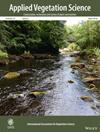Searching to improve connectivity in fragmented landscapes: Road verges as complementary habitats
Abstract
Aims
Functional connectivity is crucial for conserving biodiversity and ecosystem services in fragmented landscapes. Linear landscape elements play an important role in providing refuge for plants and pollinators, as well as serving as biological corridors. The aim of this study was to assess the importance of road verges in maintaining the ecological connectivity of plant species assemblages in the Tandilia mountain system.
Location
South America, Southern Pampa region of Argentina, Tandilia mountain system.
Methods
Using graph theory, landscape connectivity was quantified both at landscape scale and at the patch scale using the probability connectivity index (PCnum), taking into account the dispersal ability of observed species. The contribution of each landscape element to habitat availability and connectivity was evaluated using different fractions of the PCnum metric. Likewise, the influence of connectivity variables in explaining species assemblages grouped by functional categories was investigated using canonical ordination techniques.
Results
The inclusion of road verges led to an 81% increase in overall connectivity at a threshold distance of 500 m. Connectivity significantly explained the assemblages of entomophilous plant species for all dispersal distances. Annual species assemblage variation was associated with intra-patch connectivity. Variation in perennial and shrub species assemblages was explained by intra-patch and inter-patch connectivity.
Conclusions
Preservation and restoration of these linear landscape elements play a pivotal role in transitioning toward more sustainable agroecosystems. This ecological and practical information may help prioritize plant species and the sites used to restore an essential but neglected ecosystem.


 求助内容:
求助内容: 应助结果提醒方式:
应助结果提醒方式:


